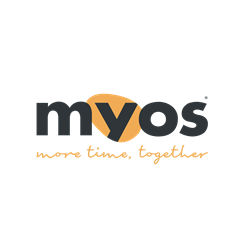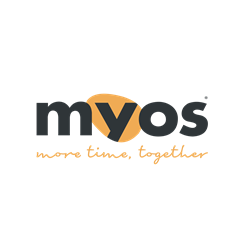
MYOS Pet Logo
“Based on studies such as this, it is my opinion that use of products that inhibit myostatin levels to reduce sarcopenia, such as Fortetropin®, should be considered a valuable component of multimodal management for the treatment of canine osteoarthritis,” said Dr. Jaffe.
CEDAR KNOLLS, N.J. (PRWEB)
March 29, 2022
MYOS CORP, a research-based, advanced nutrition company, announces that a new peer reviewed study conducted at Kansas State University to examine the impact of Fortetropin® on the quality of life and mobility in geriatric dogs has been accepted for publication in the Canadian Veterinary Journal. The study also examined the role that muscle atrophy plays in the progression of canine osteoarthritis.
Ninety percent of dogs five years of age or older suffer from osteoarthritis, a painful condition that can severely impact their mobility and quality of life. Fortetropin, the active ingredient in the MYOS Canine Muscle Formula product line, has been shown to accelerate gains in muscle tissue in multiple clinical studies involving humans and dogs.
The study conducted at Kansas State University involved supplementing geriatric dogs with a nutrition product. Half of the dogs enrolled received Fortetropin and the other half received a macronutrient-matched placebo. Dog owners completed the LOAD (Liverpool Osteoarthritis in Dogs) questionnaire, a standardized questionnaire that measures general mobility and the capability to perform exercise.
The study revealed that the Fortetropin group showed a statistically significant decrease in LOAD scores at week 6 (p=0.0261) and week 12 (p=0.0040) relative to baseline, indicating reduced severity of osteoarthritis. The placebo group showed no significant decrease in LOAD scores during the same time period.
“Osteoarthritis in dogs is one of the most common orthopedic conditions seen in veterinary practice. Multimodal management, with few surgical options, is the mainstay of its treatment. To combat the ongoing problem of generalized muscle atrophy due to aging and reduced pet mobility, the Kansas State University researchers focused on an aspect of treatment that has largely been minimally addressed. To minimize sarcopenia, and thus improve patient mobility, treatment by reduction of serum myostatin levels with Fortetropin showed promise compared to a nutritionally similar control,” stated Michael H. Jaffe, DVM, MS, CCRP, DACVS, Associate Professor, Mississippi State University College of Veterinary Medicine, an expert in canine osteoarthritis who was not involved in the study.
“The Kansas State University researchers demonstrated a statistically significant improvement in owner assessed (LOAD) mobility scores after 6 and 12 weeks of treatment compared to a placebo supplement. Based on studies such as this, it is my opinion that use of products that inhibit myostatin levels to reduce sarcopenia, such as Fortetropin, should be considered a valuable component of multimodal management for the treatment of canine osteoarthritis,” added Professor Jaffe.
“There was a statistically significant improvement in dogs that received Fortetropin supplementation at the 6- and 12-week timepoints relative to baseline as measured by LOAD scores. We did not observe such an improvement in dogs that received the macronutrient-matched placebo,” commented the Principal Investigator, Kenneth R. Harkin, DVM, DACVIM (SAIM), Professor and Section Head, Kansas State University. “Osteoarthritis is a painful condition that is very common in geriatric dogs. Typically, dogs with osteoarthritis are managed with non-steroidal anti-inflammatory drugs (NSAIDs), but these do not address the muscle loss of geriatric dogs that compounds the loss of mobility with osteoarthritis. These encouraging results with Fortetropin suggest that geriatric dogs with limited mobility may have another option,” added Professor Harkin.
“From a nutritional standpoint, veterinarians address canine osteoarthritis primarily by prescribing the glycosaminoglycans (GAGs), glucosamine hydrochloride and chondroitin sulfate to repair and regenerate cartilage that has been damaged. We believe that strengthening the quadricep muscles in dogs with osteoarthritis can be a powerful approach to managing canine osteoarthritis. For this reason, Fortetropin supplementation can play a complementary role with glucosamine hydrochloride and chondroitin sulfate supplementation in terms of managing canine osteoarthritis,” stated Joseph Mannello, CEO, MYOS Corp. “Typically, dogs with osteoarthritis are also managed in part with non-steroidal anti-inflammatory drugs (NSAIDs). Long-term NSAID use is associated with damage to the kidneys and liver. Fortetropin supplementation may enable veterinarians to reduce the dose of NSAIDs needed to manage osteoarthritic dogs,” he added.
Fortetropin is now backed by seven peer-reviewed publications in well reputed scientific journals. The completion of this most recent study at Kansas State University represents the completion of MYOS’ fourth randomized, double blind, placebo-controlled clinical study on Fortetropin which includes two human clinical studies and two veterinary clinical studies. “MYOS remains committed to continuing to pursue rigorous scientific research as we build our Human Nutrition and Animal Health businesses,” added Mr. Mannello.
About MYOS CORP.
MYOS CORP, “The Muscle Company®”, is a Cedar Knolls, NJ-based advanced nutrition company that develops and markets products that improve muscle health and performance. MYOS is the owner of Fortetropin®, a fertilized egg yolk-based product manufactured via a proprietary process to retain and optimize its biological activity. Fortetropin has been clinically shown to increase muscle size, lean body mass and reduce muscle atrophy. MYOS believes Fortetropin has the potential to redefine existing standards of physical health and wellness and produces muscle health support products featuring Fortetropin under the names of Yolked®, MYOS Canine Muscle Formula®, (Regular & Vet Strength) and MYOS Feline Formula. For more information, please visit http://www.myoscorp.com.
Share article on social media or email:

